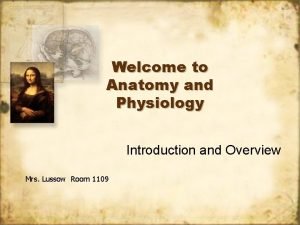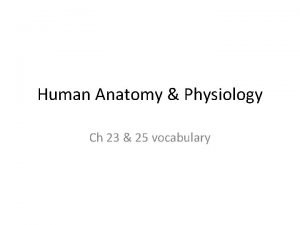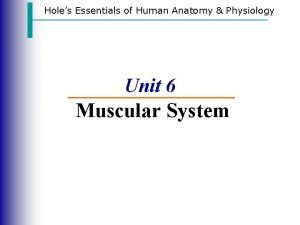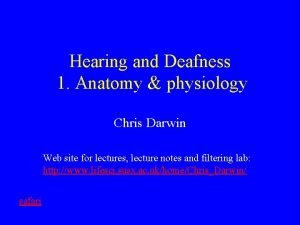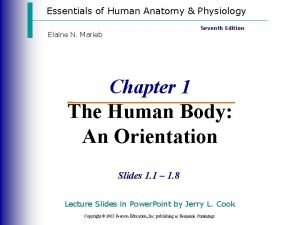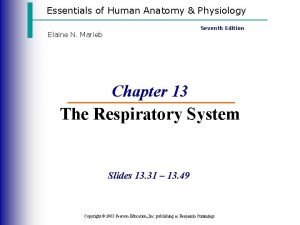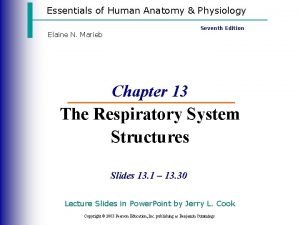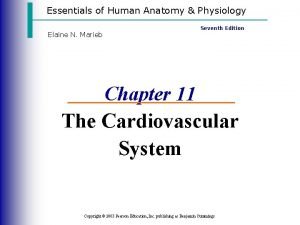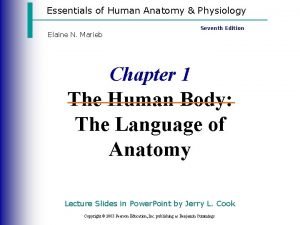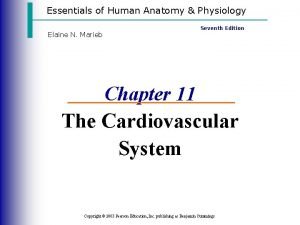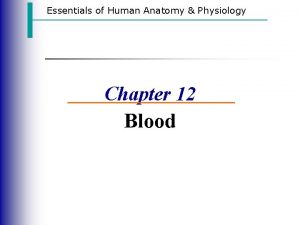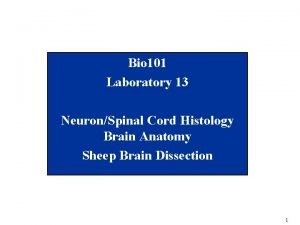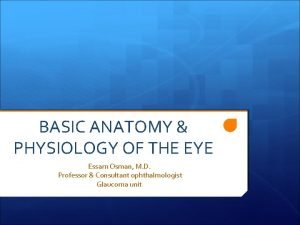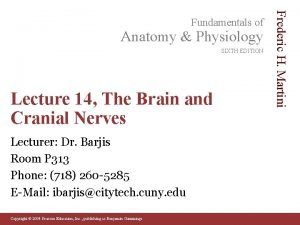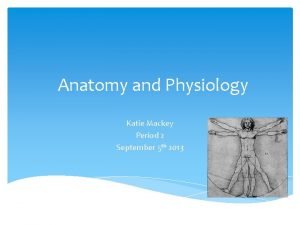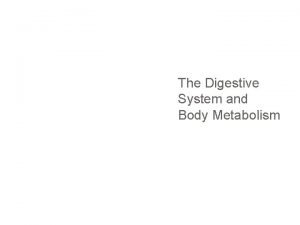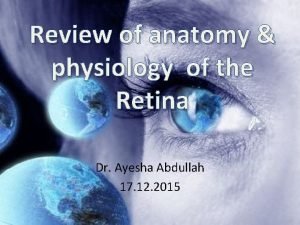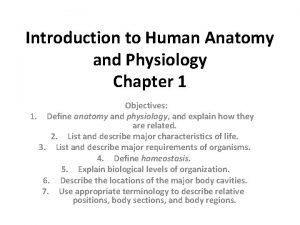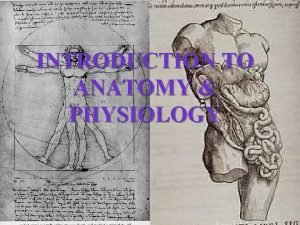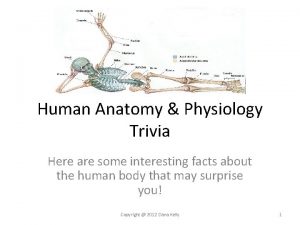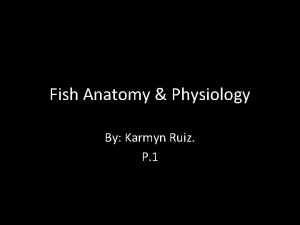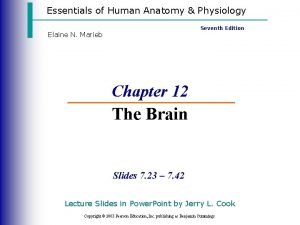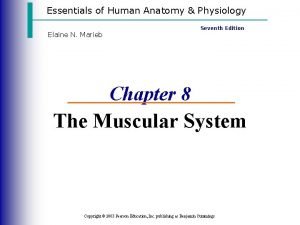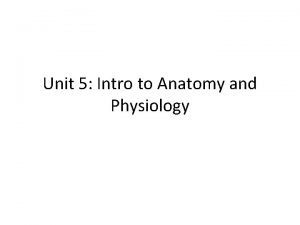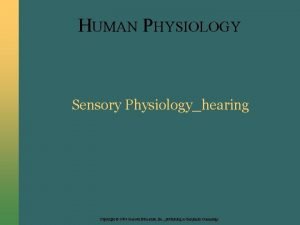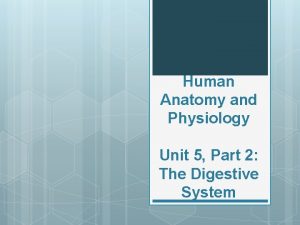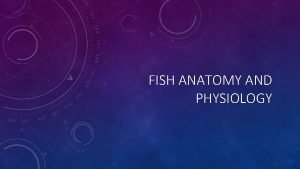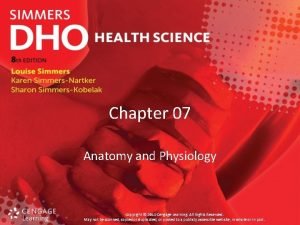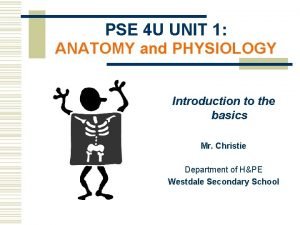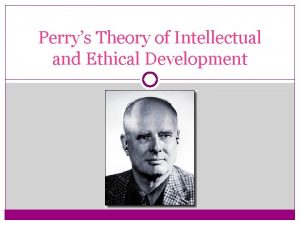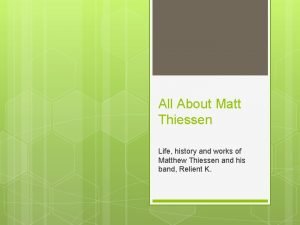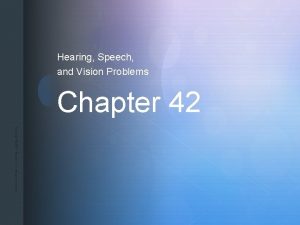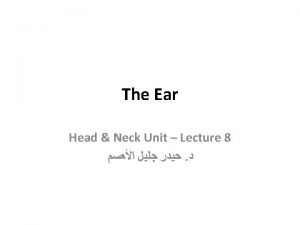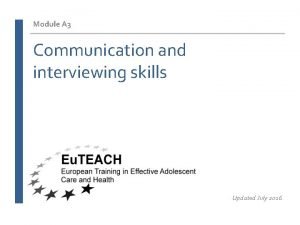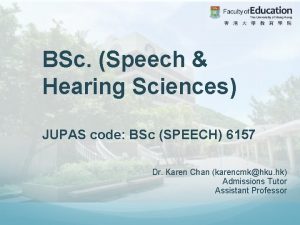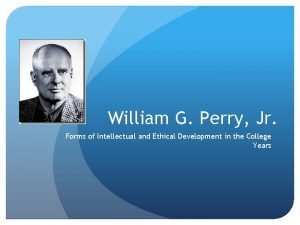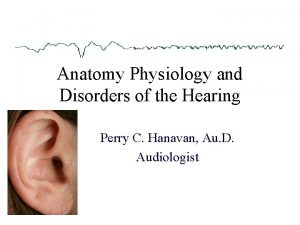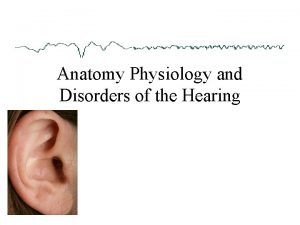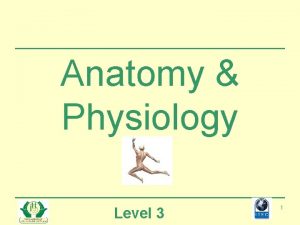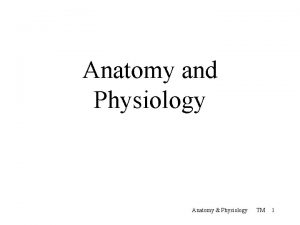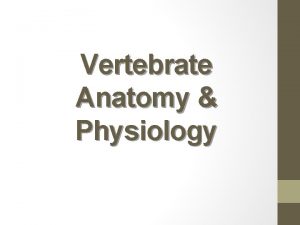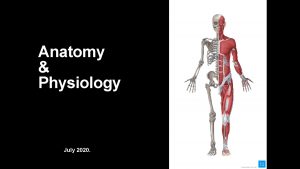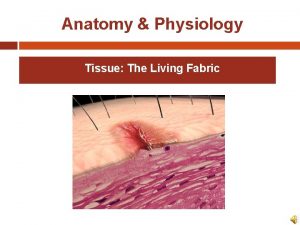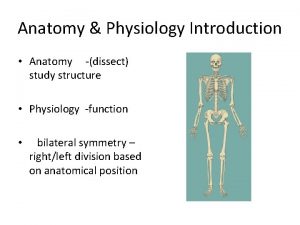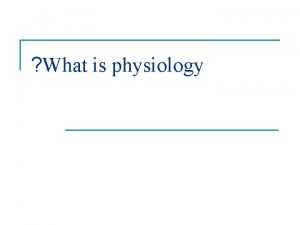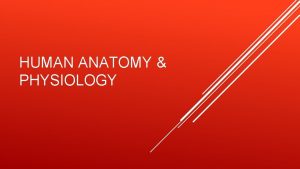Anatomy Physiology and Disorders of the Hearing Perry










































































































- Slides: 106

Anatomy Physiology and Disorders of the Hearing Perry C. Hanavan, Au. D. Audiologist

Major Divisions of the Ear Peripheral Mechanism VIII Outer Middle Inner Cranial Ear Ear Nerve Central Mechanism Brain

Question What is the purpose of the pinna? A. Cosmetics B. Sound collector C. Same side localization D. A and B E. A, B and C

Outer Ear Virtual Tour of the Ear Pinna Preauricular Tags Preauricular Pits EAM External Auditory Meatus Cerumen Q-tips Function Microtia EAM resonance Anotia Atresia

Pinna

Question Another name for pinna? A. External auditory meatus B. External auditory canal C. Ear lobe D. Auricle E. None of the above

Function of Outer Ear • • • Collect sound Localization Resonator Protection Sensitive (earlobe) Other?

Pinna • The visible portion that is commonly referred to as "the ear" • Helps localize sound sources • Directs sound into the ear • Each individual's pinna creates a distinctive imprint on the acoustic wave traveling into the auditory canal

External Auditory Meatus • Extends from the pinna to the tympanic membrane – About 26 millimeters (mm) in length and 7 mm in diameter in adult ear. – Size and shape vary among individuals. • Protects the eardrum • Resonator – Provides about 10 decibels (d. B) of gain to the eardrum at around 3, 300 Hertz (Hz). • The net effect of the head, pinna, and ear canal is that sounds in the 2, 000 to 4, 000 Hz region are amplified by 10 to 15 d. B. – Sensitivity to sounds greatest in this frequency region – Noises in this range are the most hazardous to hearing

Outer Ear Resonance • Influence of pinna (p) • Influence of ear canal (m) • Combine influence (t) • At 3000 Hz, the final amplification (t) is 20 d. B

Question Cerumen should be routinely removed from the ear canal? A. True B. False

Cerumen • The purpose of wax: – Repel water – Trap dust, sand particles, microorganisms, and other debris – Moisturize epithelium in ear canal – Odor discourages insects – Antibiotic, antiviral, antifungal properties – Cleanse ear canal

Embryological Development • External Ear Development

Disorders of the Outer Ear Accessory auricle Additional pinna or auricular tissue Anotia Congenital absence of pinna Cleft pinna Congenital fissure of the pinna Coloboma lobuli Congenital fissure of the earlobe Macrotia Congenital excessive enlargement of the auricle Microtia Congenital small pinna Melotia Congenital displacement of the pinna Low-set-ears Congenitally displaced pinna Polyotia Additional pinna on one or both sides Preauricular tags Small appendage anterior to pinna Scroll ear Rim (helix) of pinna is rolled forward and inward

Outer Ear Hearing Disorders • Outer ear • CHARGE • Down Syndrome – Ears small and low set • Fetal Alcohol Syndrome – Deformed ears • Di. George syndrome – Low set ears

Grow Ear?

External Ear Care Hazardous to health: • Ear candling • Swabs • Foreign objects

Time of Onset Congenital Present at birth Acquired Occurring after birth Adventitious Occurring after birth Acute Sudden onset or short duration Chronic Long duration Sudden Rapid onset Gradual Occurring slowly Temporary Limited duration Permanent Irreversible Progressive Increasing in degree over time Fluctuating Increasing and decreasing in degree of loss

Middle Ear The function of the middle ear is to? A. Cause middle ear infections in young children B. Amplify sounds C. Interpret sounds D. Analyze sounds E. None of the above

Middle Ear The Eustachian tube is a part of the middle ear? A. No, it is a part of the inner ear B. No, it isn’t part of the hearing mechanism C. Yes D. I don’t know

Middle Ear Which is not true? A. There are two middle ear muscles B. There are three ossicles C. There are three layers of tympanic membrane tissue D. The acoustic reflex occurs from soft sounds E. The stapes is the smallest bone in the human body

Middle Ear Virtual Tour of the Ear Middle Ear Cavity Tympanic Membrane Ossicles Middle Ear Muscles Eustachian Tube Mastoid Ossicles Middle Ear Muscles Mastoid Eustachian Tube Function Amplifier Cholesteatoma Temporal bone fractures Otitis Media PE tubes Otosclerosis

Function of Middle Ear • Conduction – Conduct sound from the outer ear to the inner ear • Protection – Creates a barrier that protects the middle and inner areas from foreign objects – Middle ear muscles may provide protection from loud sounds • Transducer – Converts acoustic energy to mechanical energy – Converts mechanical energy to hydraulic energy • Amplifier – Transformer action of the middle ear – only about 1/1000 of the acoustic energy in air would be transmitted to the inner-ear fluids (about 30 d. B hearing loss)

The middle ear: A. Converts acoustic energy to hydraulic B. Converts hydraulic energy to mechanical C. Converts acoustic energy to mechanical D. Converts acoustic energy to electrical E. Converts mechanical to electrical

Middle Ear Tympanum: Timpani, or kettledrums, are musical instruments in the percussion family. A type of drum, they consist of a skin called a head stretched over a large bowl commonly made of copper. They are played by striking the head with a special drum stick called a timpani stick. Timpani evolved from military drums to become a staple of the classical orchestra in the 17 th century. Today, they are used in many types of musical ensembles including classical orchestra

Tympanic Membrane • The eardrum separates the outer ear from the middle ear • Creates a barrier that protects the middle and inner areas from foreign objects • Cone-shaped in appearance – about 17. 5 mm in diameter • The eardrum vibrates in response to sound pressure waves. • The membrane movement is incredibly small – as little as one-billionth of a centimeter

The pars tensa portion of the TM: A. Consists of 2 layers of tissue B. Consists of 4 layers of tissue C. Consists of 1 layer of tissue D. Consists of 3 layers of tissue E. Consists of 5 layers of tissue

Eustachian Tube • The eustachian tube connects the front wall of the middle ear with the nasopharynx • The eustachian tube also operates like a valve, which opens during swallowing and yawning – This equalizes the pressure on either side of the eardrum, which is necessary for optimal hearing. – Without this function, a difference between the static pressure in the middle ear and the outside pressure may develop, causing the eardrum to displace inward or outward • This reduces the efficiency of the middle ear and less acoustic energy will be transmitted to the inner ear.

The Eustachian tube: A. Opens when one yawns B. Opens when one smiles C. Opens when one blinks D. It is always open E. Never opens

Ossicles • Malleus (hammer) • Incus (anvil) • Stapes (stirrup) smallest bone of the body

The middle ear amplifies sound: A. About 15 d. B B. About 25 d. B C. About 35 d. B D. About 20 d. B E. About 40 d. B

Transformer/Amplifier • Transform the vibrating motion of the eardrum into motion of the stapes. • The middle ear enhances the transfer of acoustical energy in two ways: – The area of the eardrum is about 17 times larger than the oval window • The effective pressure (force per unit area) is increased by this amount. – The ossicles produce a lever action that further amplifies the pressure • Without the transformer action of middle ear, about 1/1000 of acoustic energy in air transmitted to inner-ear fluids (about 30 d. B loss). • Malleus and incus vibrate together, transmitting the sound waves from the eardrum to the footplate of the stapes (this pushes the oval window in and out)(mechanical energy)

Transformer/Amplifier • Area ratio – Thumbtack • Lever – crowbar

Which provides the most amplification in the middle ear? A. The lever hypothesis B. The area/ratio hypothesis C. The Hanavan principle D. I don’t know E. None of the above

Middle Ear Muscles • Tensor tympani – Attached to malleus – Innervated by V, trigeminal nerve • Stapedius – Attached to stapes – Innervated by VII, facial nerve • Middle Ear Muscle Function: – Help maintain ossicles in proper position – Protect inner ear from excessive sound levels • When ear exposed to sound levels above 70 d. B, the muscles contract, decreasing amount of energy transferred to inner ear – This protective reflex termed "acoustic reflex"

The VII cranial nerve innervates: A. Tensor tympani muscle B. Incus C. Stapedial muscle D. Malleus E. Stapes

The tensor tympani: A. Innervated by the facial nerve B. Innervated by the trigeminal nerve C. Innervated by the VII cranial nerve D. Innervated by the VIII cranial nerve E. Innervated by the VI cranial nerve

Ligaments of Middle Ear • Function – restrict and confine the effect of ossicles to act as a lever – restrict movements to reduce the chance of damage to the inner ear – prevents distortion to sound

Mastoid

Mastitis A. Inflammation of the mastoid B. Inflammation of the breast C. Cancer of the mast cells D. A and B E. B and C

Question The correct order of the ossicles from the TM to inner ear is? A. Anvil, hammer, stapes B. Hammer, incus, anvil C. Hammer, anvil, stapes D. Stapes, anvil, hammer E. Malleus, stapes, incus

Development of Middle Ear • Middle Ear Development

Middle Ear Disorders • Middle Ear disorders – – – – – Acute otitis media Otosclerosis Disarticulation Mastoiditis Tympanosclerosis OME TM Perforation TM Retraction Cholesteatoma • Down Syndrome • Treacher Collins Syndrome • BOR Syndrome

OM/OME

Cholesteatoma

Otosclerosis • Develops most frequently between ages of 10 and 30. • About 10– 15% of patients have unilateral loss. • Affects women more frequently than men by a ratio of 2: 1. • Pregnancy once thought to be a risk factor for the development and / or worsening of otosclerosis…recent studies have disputed this. • May progress to nerve deafness called cochlear otosclerosis.

Question The Amy Tan syndrome is: A. Down syndrome B. BOR syndrome C. Treacher Collins syndrome D. Measles syndrome E. Waardenburg syndrome

Question The function of the inner ear: A. Balance B. Hearing C. Touch D. All the above E. A and B

Inner Ear Virtual Tour of the Ear Vestibular Auditory semicircular canals utricle and saccule Cochlear traveling wave Vestibular traveling wave pathologies

Function of Inner Ear • Convert mechanical sound waves to neural impulses that can be recognized by the brain for: – Hearing – Balance

Balance • Linear motion • Rotary motion

Question Which is true about the inner ear and balance? A. The semicircular canals detect linear motion B. The utricle and saccule detect linear motion C. The cochlea detects linear motion D. The utricle and saccule detect rotary motion

Cochlea • The cochlea resembles a snail shell and spirals for about 2 3/4 turns around a bony column • Within the cochlea are three canals: – Scala Vestibuli – Scala Tympani – Scala Media

Question The channel that houses the organ of Corti: A. Scala tympani B. Scala media C. Scala vestibuli D. Semicircular canals E. B and D

Anatomy of the adult mammalian cochlea Barald, K. F. et al. Development 2004; 131: 4119 -4130

Organ of Corti

Organ of Corti

Organ of Corti

OHC vs. IHC Function

OHC Motility Models

Afferent Neural Innervations

Hair Cells • Outer Hair Cells • Inner Hair Cells • OHC movie

OCH Cilia Theory: Tip-links <<<IHC OHC >>>

OHC Cilia: Tip-links

Tip Link Protiens

Stereocilia move sideways and lengthen (Oct 2, 2012)

Flexoelectric Effect • Quiet sounds are magnified by bundles of tiny, hair-like tubes atop "hair cells" in the ear (stereocilia: when the tubes dance back and forth, they act as "flexoelectric motors" that amplify sound mechanically. • "It's like a car's power steering system. " – " You turn the wheel and mechanical power is added. Here, the incoming sound is like your hand turning the wheel, but to drive, you need to add power to it. These hair bundles add power to the sound. If you did not have this mechanism, you would need a powerful hearing aid. “ – http: //www. medicalnewstoday. com/articles/147081. php

OHC Somatic Motility

Question Which cells are motile? A. Brain cells B. Inner hair cells C. Outer hair cells D. B and C E. None of the above

OHC—With and Without Prestin • No other cells except OHC • Prestin is the motor protein of mammalian OHCs. • It is highly expressed in OHC, and is not expressed in nonmotile IHC.

OHC—With and Without Prestin About 55 d. B difference OHC in Prestin Knockout Mouse

Traveling Waves • • Traveling wave Basilar membrane Traveling Wave info Cochlear Traveling Wave

Question High frequencies stimulate this part of inner ear: A. Apical portion of inner ear B. Basilar portion of inner ear C. Utricle D. Saccule E. Semicircular canals

Inner Ear Etiologies • Genetic – Connexin 26 • Excessive Noise • Head Trauma • Metabolic – Diabetes, kidney disfunction, thyroid dysfunction • Ototoxic – Gentamiacin, cisplatin, etc. • Disease

Connexin 26

Noise Trauma

Question Persons with diabetes are at greater risk for hearing loss…this would be? A. Metabolic B. Noise related C. Ototoxic D. Genetic E. Acoustic trauma related

Question Persons with Connexin 26 are at greater risk for hearing loss…this would be: A. Metabolic B. Noise related C. Ototoxic D. Genetic E. Acoustic trauma related

Developmental • Inner Ear Embryological Development

Question The hearing nerve is located in: A. Eustachian tube B. External auditory meatus C. Internal auditory meatus D. Organ of Corti E. Tympani

Question The auditory nerve is which cranial nerve: A. VI B. VII C. VIII D. V E. X

VIII Cranial Nerve Virtual Tour of the Ear Auditory Branch Vestibular Branch Spiral ganglion Acoustic Tumors

Standard ABR Cross-section of Internal Auditory Canal Sup. Vest Nerve Facial Nerve HIGHFREQUENCY FIBERS Acoustic Nerve Large Tumor Abnormal Standard ABR TUMOR The wave V latency used in the standard ABR IT 5 and I-V delay measures is dominated by neural activity from the high-frequency regions of the cochlea. Thus, unless the tumor affects these high-frequency fibers sufficiently, standard ABR latencies will be normal. Inf. Vest Nerve Small Tumor Abnormal Standard ABR Small Tumor Normal Standard ABR

IAM

VIII Cranial Nerve

Spiral Ganglion

Question The Auditory Nerve is: A. V Cranial Nerve B. VI Cranial Nerve C. VII Cranial Nerve D. VIII Cranial Nerve E. IX Cranial Nerve

Acoustic Neuroma • Tumor

Neurofibromatosis (NF 2) • Bilateral acoustic neuromas (tumors of the vestibulocochlear nerve or cranial nerve VIII also known as schwannoma) develop, often leading to hearing loss • Multiple inherited schwannomas and meningiomas • Non-malignant brain tumors (benign)

Acoustic Neuroma

Question Another term for acoustic tumor: A. VII cranial nerve tumor B. Vestibular schwannoma C. Facial nerve tumor D. Ear schwannoma

Stem Cells Restore Hearing Human stem cells regenerate auditory nerve cells in gerbils

Central Auditory Mechanism Virtual Tour of the Ear Auditory Path

Central Auditory Path

Auditory Pathway - CNS

Tonotopic

Etiologies • Central auditory processing disorders – Brainstem – Cerebrum – Corpus callosum • Learning disorders • Vascular – Stoke • Head trauma • Tumors

Nonorganic Hearing Loss • Sometimes referred to as functional, feigning, etc. • No physical evidence of hearing loss • Conscious and unconscious • Adults: medical/legal reasons • Children: attention, psychological, reward, etc.

Development of the otocyst Barald, K. F. et al. Development 2004; 131: 4119 -4130

Inductive interactions that regulate otocyst induction and ventral patterning Barald, K. F. et al. Development 2004; 131: 4119 -4130

Development of the cochlear duct and organ of Corti Barald, K. F. et al. Development 2004; 131: 4119 -4130

Effects of modulating gene expression on development of the organ of Corti (OC) Barald, K. F. et al. Development 2004; 131: 4119 -4130

Generation of stereociliary bundle orientation Barald, K. F. et al. Development 2004; 131: 4119 -4130



Six 1 expression during inner ear development Zheng, W. et al. Development 2003; 130: 3989 -4000
 The upper airways
The upper airways Tattoo anatomy and physiology
Tattoo anatomy and physiology Science olympiad anatomy and physiology
Science olympiad anatomy and physiology Perfect vs imperfect flower
Perfect vs imperfect flower Anatomy and physiology bones
Anatomy and physiology bones Pud triple therapy
Pud triple therapy Liver anatomy
Liver anatomy Difference between anatomy and physiology
Difference between anatomy and physiology Difference between anatomy and physiology
Difference between anatomy and physiology Blood anatomy and physiology
Blood anatomy and physiology The central sulcus divides which two lobes? (figure 14-13)
The central sulcus divides which two lobes? (figure 14-13) Endomysium
Endomysium Http://anatomy and physiology
Http://anatomy and physiology Chapter 1 introduction to human anatomy and physiology
Chapter 1 introduction to human anatomy and physiology Anatomy and physiology of appendicitis
Anatomy and physiology of appendicitis Aohs foundations of anatomy and physiology 1
Aohs foundations of anatomy and physiology 1 Aohs foundations of anatomy and physiology 1
Aohs foundations of anatomy and physiology 1 Anatomy and physiology of swine
Anatomy and physiology of swine Anatomy and physiology chapter 8 special senses
Anatomy and physiology chapter 8 special senses Chapter 13 anatomy and physiology of pregnancy
Chapter 13 anatomy and physiology of pregnancy Unit 26 self evaluation answers
Unit 26 self evaluation answers Science olympiad forensics cheat sheet
Science olympiad forensics cheat sheet Chapter 2 basic chemistry anatomy and physiology
Chapter 2 basic chemistry anatomy and physiology Gastric emptying ppt
Gastric emptying ppt Anatomy and physiology of pancreas
Anatomy and physiology of pancreas Heat and cold
Heat and cold Art labeling activity: figure 14.1 (3 of 3)
Art labeling activity: figure 14.1 (3 of 3) Chapter 10 blood anatomy and physiology
Chapter 10 blood anatomy and physiology Aohs foundations of anatomy and physiology 1
Aohs foundations of anatomy and physiology 1 Aohs foundations of anatomy and physiology 1
Aohs foundations of anatomy and physiology 1 What produces bile
What produces bile Anatomy and physiology chapter 15
Anatomy and physiology chapter 15 Cornell notes for anatomy and physiology
Cornell notes for anatomy and physiology Anatomy and physiology ninth edition
Anatomy and physiology ninth edition Anatomy and physiology chapter 1
Anatomy and physiology chapter 1 Holes anatomy and physiology chapter 1
Holes anatomy and physiology chapter 1 Holes essential of human anatomy and physiology
Holes essential of human anatomy and physiology Anatomy and physiology unit 7 cardiovascular system
Anatomy and physiology unit 7 cardiovascular system Gi tract histology
Gi tract histology Anatomy and physiology
Anatomy and physiology Medial lateral distal proximal
Medial lateral distal proximal Aohs foundations of anatomy and physiology 1
Aohs foundations of anatomy and physiology 1 Aohs foundations of anatomy and physiology 1
Aohs foundations of anatomy and physiology 1 Cranial cephalic
Cranial cephalic Human physiology exam 1
Human physiology exam 1 Welcome to anatomy and physiology
Welcome to anatomy and physiology Physiology of the foot and ankle
Physiology of the foot and ankle Skin cancer
Skin cancer Pancreas histology slide
Pancreas histology slide Anatomy and physiology vocabulary
Anatomy and physiology vocabulary Anatomy and physiology
Anatomy and physiology Biceps muscle names
Biceps muscle names Anatomy and physiology
Anatomy and physiology Body landmarks diagram
Body landmarks diagram Anatomy and physiology
Anatomy and physiology Anatomy and physiology
Anatomy and physiology Thyroid anatomy
Thyroid anatomy Dorsifelxion
Dorsifelxion Anatomy and physiology
Anatomy and physiology Anatomy and physiology
Anatomy and physiology Anatomy and physiology
Anatomy and physiology Anatomy and physiology
Anatomy and physiology Chapter 2 human reproductive anatomy and physiology
Chapter 2 human reproductive anatomy and physiology Human anatomy and physiology 10th edition
Human anatomy and physiology 10th edition Inferior view of sheep brain labeled
Inferior view of sheep brain labeled Anatomy and physiology of eye
Anatomy and physiology of eye Telencephalon
Telencephalon Irn.org anatomy and physiology
Irn.org anatomy and physiology Anatomy and physiology body parts
Anatomy and physiology body parts Unit 26 animal anatomy physiology and nutrition
Unit 26 animal anatomy physiology and nutrition The digestive system and body metabolism
The digestive system and body metabolism Anatomy and physiology of the retina
Anatomy and physiology of the retina Anatomy and physiology
Anatomy and physiology Anatomy and physiology of meningitis ppt
Anatomy and physiology of meningitis ppt Jeopardy anatomy and physiology game
Jeopardy anatomy and physiology game What is homeostasis
What is homeostasis Anatomy and physiology
Anatomy and physiology Picture of human respiratory system
Picture of human respiratory system Anatomy and physiology trivia
Anatomy and physiology trivia Fish anatomy and physiology
Fish anatomy and physiology Brain anatomy and physiology
Brain anatomy and physiology Anatomy and physiology
Anatomy and physiology Long axis of body
Long axis of body 2012 pearson education inc anatomy and physiology
2012 pearson education inc anatomy and physiology Fundus
Fundus Fish anatomy and physiology
Fish anatomy and physiology Anterior surface of scapula
Anterior surface of scapula Chapter 6 general anatomy and physiology
Chapter 6 general anatomy and physiology Cengage anatomy and physiology
Cengage anatomy and physiology Pse4u
Pse4u Perry’s theory of intellectual and ethical development
Perry’s theory of intellectual and ethical development Katy perry relient k
Katy perry relient k Chapter 42 hearing speech and vision problems
Chapter 42 hearing speech and vision problems The receptors for hearing are the
The receptors for hearing are the Middle ear
Middle ear Sight hearing taste smell and touch
Sight hearing taste smell and touch Headsss
Headsss Proxemics in communication skills
Proxemics in communication skills Hku speech and hearing
Hku speech and hearing Blue whale facts
Blue whale facts Perry glasser
Perry glasser Roar onomatopoeia
Roar onomatopoeia Dr richard perry
Dr richard perry Figurative language in roar by katy perry
Figurative language in roar by katy perry Commodore matthew perry apush
Commodore matthew perry apush Reece map
Reece map William g perry jr
William g perry jr













































